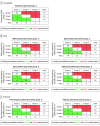Assessment of Disparities Associated With a Crisis Standards of Care Resource Allocation Algorithm for Patients in 2 US Hospitals During the COVID-19 Pandemic
- PMID: 33739434
- PMCID: PMC7980099
- DOI: 10.1001/jamanetworkopen.2021.4149
Assessment of Disparities Associated With a Crisis Standards of Care Resource Allocation Algorithm for Patients in 2 US Hospitals During the COVID-19 Pandemic
Abstract
Importance: Significant concern has been raised that crisis standards of care policies aimed at guiding resource allocation may be biased against people based on race/ethnicity.
Objective: To evaluate whether unanticipated disparities by race or ethnicity arise from a single institution's resource allocation policy.
Design, setting, and participants: This cohort study included adults (aged ≥18 years) who were cared for on a coronavirus disease 2019 (COVID-19) ward or in a monitored unit requiring invasive or noninvasive ventilation or high-flow nasal cannula between May 26 and July 14, 2020, at 2 academic hospitals in Miami, Florida.
Exposures: Race (ie, White, Black, Asian, multiracial) and ethnicity (ie, non-Hispanic, Hispanic).
Main outcomes and measures: The primary outcome was based on a resource allocation priority score (range, 1-8, with 1 indicating highest and 8 indicating lowest priority) that was assigned daily based on both estimated short-term (using Sequential Organ Failure Assessment score) and longer-term (using comorbidities) mortality. There were 2 coprimary outcomes: maximum and minimum score for each patient over all eligible patient-days. Standard summary statistics were used to describe the cohort, and multivariable Poisson regression was used to identify associations of race and ethnicity with each outcome.
Results: The cohort consisted of 5613 patient-days of data from 1127 patients (median [interquartile range {IQR}] age, 62.7 [51.7-73.7]; 607 [53.9%] men). Of these, 711 (63.1%) were White patients, 323 (28.7%) were Black patients, 8 (0.7%) were Asian patients, and 31 (2.8%) were multiracial patients; 480 (42.6%) were non-Hispanic patients, and 611 (54.2%) were Hispanic patients. The median (IQR) maximum priority score for the cohort was 3 (1-4); the median (IQR) minimum score was 2 (1-3). After adjustment, there was no association of race with maximum priority score using White patients as the reference group (Black patients: incidence rate ratio [IRR], 1.00; 95% CI, 0.89-1.12; Asian patients: IRR, 0.95; 95% CI. 0.62-1.45; multiracial patients: IRR, 0.93; 95% CI, 0.72-1.19) or of ethnicity using non-Hispanic patients as the reference group (Hispanic patients: IRR, 0.98; 95% CI, 0.88-1.10); similarly, no association was found with minimum score for race, again with White patients as the reference group (Black patients: IRR, 1.01; 95% CI, 0.90-1.14; Asian patients: IRR, 0.96; 95% CI, 0.62-1.49; multiracial patients: IRR, 0.81; 95% CI, 0.61-1.07) or ethnicity, again with non-Hispanic patients as the reference group (Hispanic patients: IRR, 1.00; 95% CI, 0.89-1.13).
Conclusions and relevance: In this cohort study of adult patients admitted to a COVID-19 unit at 2 US hospitals, there was no association of race or ethnicity with the priority score underpinning the resource allocation policy. Despite this finding, any policy to guide altered standards of care during a crisis should be monitored to ensure equitable distribution of resources.
Conflict of interest statement
Figures



Comment in
-
Racial Equity in Crisis Standards of Care-Reassuring Data or Reason for Concern?JAMA Netw Open. 2021 Mar 1;4(3):e214527. doi: 10.1001/jamanetworkopen.2021.4527. JAMA Netw Open. 2021. PMID: 33739428 No abstract available.
References
-
- Institute of Medicine Committee on Guidance for Establishing Standards of Care for Use in Disaster Situations . Guidance for Establishing Crisis Standards of Care for Use in Disaster Situations: A Letter Report. Altevogt BM, Stroud C, Hanson SL, Hanfling D, Gostin LO, eds. Published 2009. Accessed August 24, 2020. https://www.nap.edu/download/12749# - PubMed
-
- American Medical Association . Crisis standards of care: guidance from the AMA Code of Medical Ethics. Updated April 5, 2020. Accessed August 24, 2020. https://www.ama-assn.org/delivering-care/ethics/crisis-standards-care-gu...
-
- White DB, Katz M, Luce J, et al. . Allocation of scarce critical care resources during a public health emergency. University of Pittsburgh School of Medicine. Department of Critical Care Medicine. Published April 15, 2020. Accessed August 24, 2020. https://ccm.pitt.edu/sites/default/files/UnivPittsburgh_ModelHospitalRes...
Publication types
MeSH terms
LinkOut - more resources
Full Text Sources
Other Literature Sources
Medical

